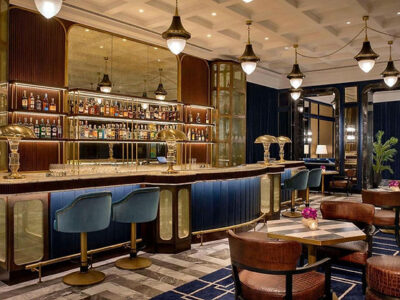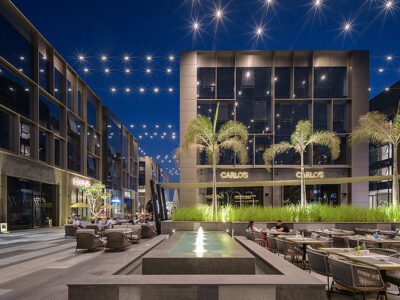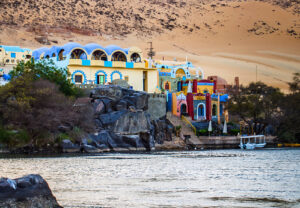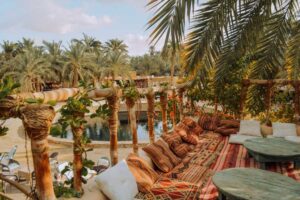
El Moez Street (also spelled Muizz or Muiz) is the shorthand version of its proper name: El Moez Li-Deen Allah Al-Fatimi Street. You can probably see why we locals shortened it.
So what exactly is Moez Street?
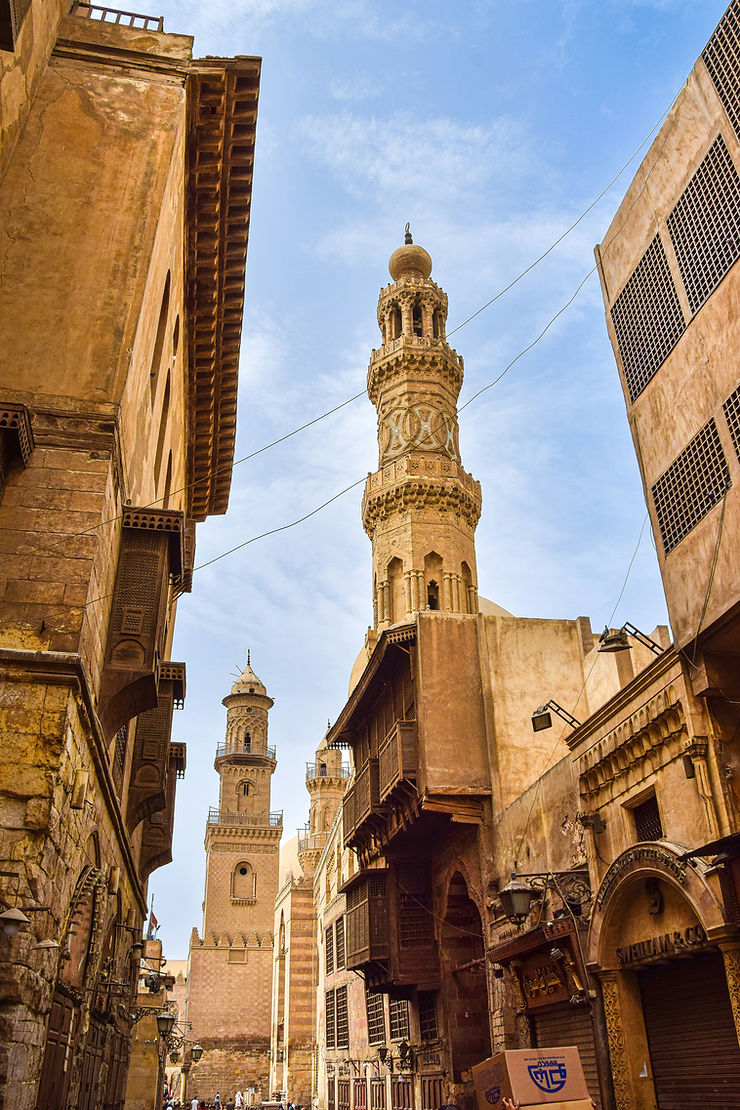
It’s a 1 km long pedestrian street, and to quote the UN, it has “the greatest concentration of medieval architectural treasures in the Islamic world”.
It might not be the Pyramids, but it’s a definite must-see to get a true feel for the history of Cairo as a city, and to see some frankly mind-blowing medieval Islamic architecture and art. And not in a stuffy, museum-type behind-the-glass environment — it’s a free pedestrian street with the architecture all around you, so you don’t have to worry about paying money to stare at super curated things that you a) don’t really understand, and b) are kind of boring. One thing we can promise about Moez Street — it’s not boring, that’s for sure.
A little background first:
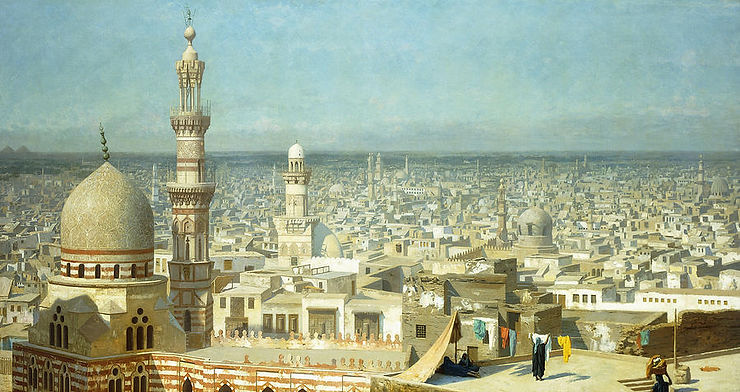
Cairo from above by Jean Leon Gerome (1824-1904)
El Moez Street is found in an area of Cairo known officially as Historic Cairo, but we locals refer to it as ‘Old Cairo’ (masr el adeema in Arabic).
Cairo was officially founded in 969 AD by the Fatimids (a North African Shi’ite Muslim caliphate) and the modern-day area of Old Cairo consists of the remnants of the pre-Cairo cities (Fustat, Al Askar, Al Qatta’i), as well as Coptic Cairo and Islamic Cairo. Moez Street is named after the 4th caliph of the Fatimid dynasty.
You might also like: Cairo’s City of the Dead – A Local’s Guide
Old Cairo/Historic Cairo was deemed a UNESCO World Heritage Site in 1979, and it was called “one of the world’s oldest Islamic cities, with its famous mosques, madrasas, hammams and fountains” and “the new centre of the Islamic world, reaching its golden age in the 14th century.”
Read more about Egypt’s 7 UNESCO World Heritage Sites here.
Cairo’s Islamic History
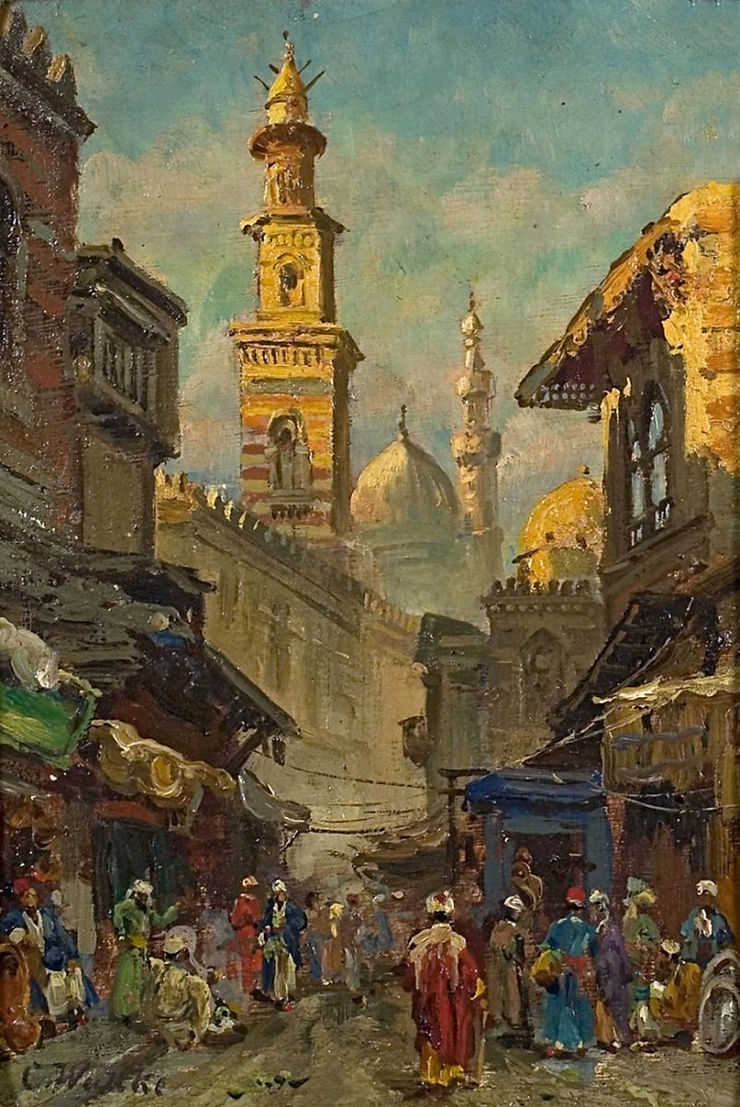
Moez Street by Carl Wuttke (1849-1927)
Briefly explaining the Islamic history of Egypt and Cairo in particular isn’t easy, what with all the different Islamic dynasties, but it’s important to have an idea of what we’re talking about when we reference something as being Fatimid, Mamluk, Ottoman or what have you.
Egypt was conquered by Arab Muslims in 641 AD, led by Amr ibn Al-As, who proceeded to build the first mosque in Egypt and all of Africa (a reconstructed mosque still stands in Cairo today). Although the capital of Egypt at the time was Alexandria, Amr ibn Al-As created a new capital where his mosque was, and named it Fustat.
More than 300 years later, in 969 AD, the Fatimid Caliph El Moez Li-Deen Allah Al-Fatimi built his new capital Cairo (Al Qahera in Arabic) north of Fustat, and later absorbed it. When Cairo was first built, it was a walled enclosure for the royal caliphs, and part of that wall still remains today — El Moez Street runs between two different gates of the wall.
Since the foundation of Cairo, it was under several different Islamic dynasties:
Fatimid (969 – 1171 AD) – originally Arab, they had a North African Shi’ite caliphate
Ayyubid (1171 – 1250 AD) – a Sunni Muslim dynasty of Kurdish origins, led by Salah El Din
Mamluk (1250 – 1517 AD) – a sultanate ruled by military slaves of Turkic and Circassian origins
Ottoman (1517 – 1867 AD) – part of the Ottoman Empire. Egypt became an autonomous Khedivate under Ottoman influence after 1867
Egypt wouldn’t achieve full independence from outside powers until it became a republic in 1952.
Pheeeeww ok we are now officially done with the history lesson.
Moez Street Today: What To Expect
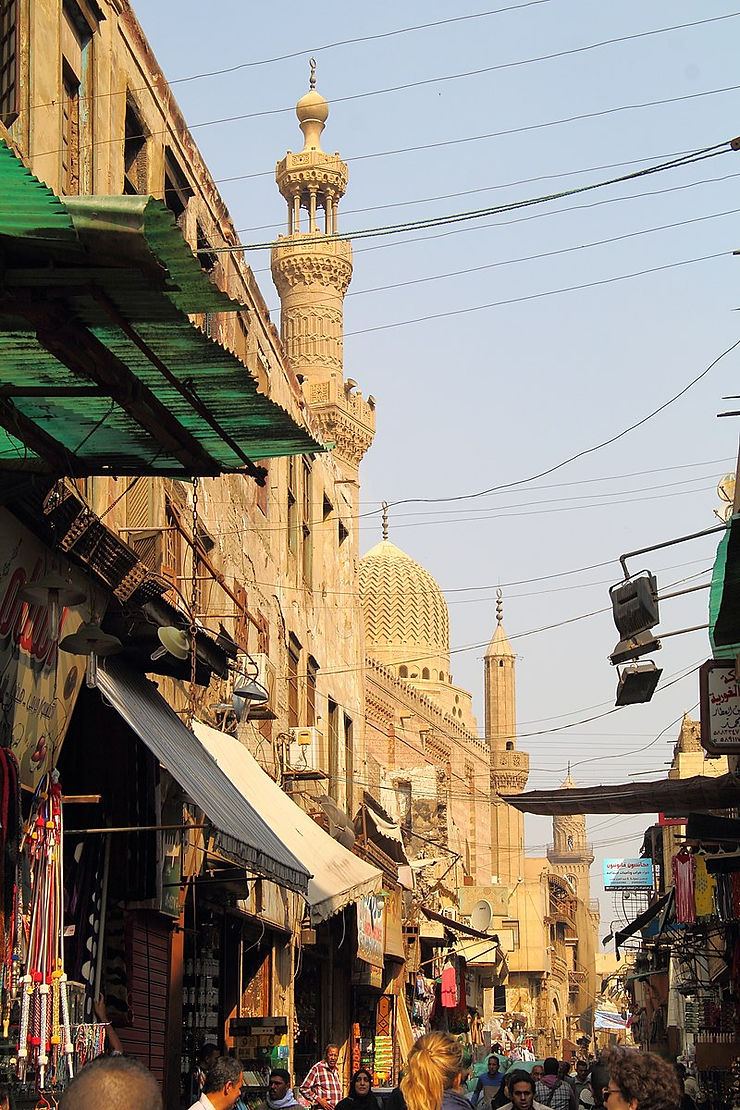
Moez Street today is a mix of medieval mosques and buildings alongside modern vendors and shops in an Old Cairo neighborhood called Gamaleya, and the street is adjacent to the world-famous bazaar Khan el Khalili (for more info, you can read our full Khan el Khalili guide here).
The street starts at the northern Bab El Fotouh (one of the original gates to the old walled city), then meanders south for a bit until it intersects with Al Azhar street. Cross Al Azhar, and El Moez continues through the El Ghouri Complex (El Ghoureya in Arabic), ending at Bab Zuweila and the Tentmakers’ Market in the south.
You can either walk down the street and admire the buildings just from the outside, or you can explore some of them from the inside. Most of the mosques have free entry, but some of the other medieval buildings require a ticket and have working hours.
Starting from the El Ghouri Complex, the street gets pretty chaotic with all the different shops and vendors, so just don’t expect a calm stroll and you’ll be fine.
How To Get There
The easiest way to get to Moez Street is to have a taxi or Uber drop you off at Bab el Fotouh in Gamaleya. Just plug in the destination on your Uber app, or tell the cab driver (just make sure he knows where it is first — some Egyptian cab drivers really need to give up their day job).
From Bab el Fotouh, you just walk through the gate and there you are!
Moez Street Tickets and Working Hours
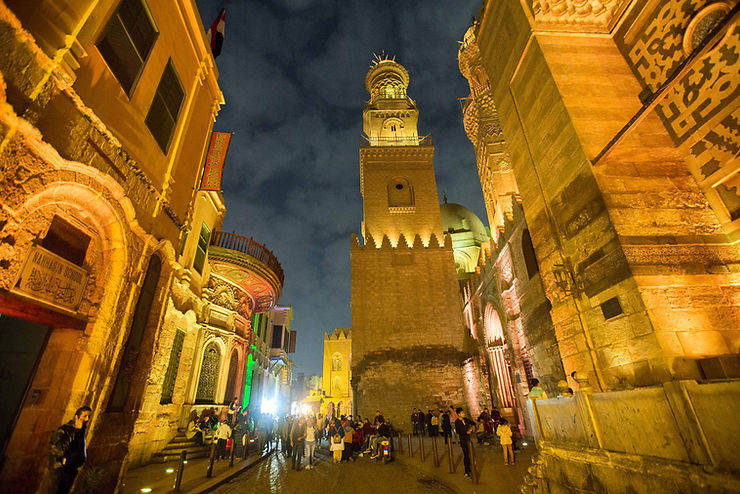
The street itself is free of charge, and is just as popular at night as it is during the day, mainly because of how the buildings are lit in the dark.
Mosques: most of the mosques are free to enter, but if you’re a woman make sure that you have something to cover your hair (and aren’t wearing something too short/revealing) and both sexes need to take off their shoes at the entrance (you can bring them in with you though).
Places like the Qalawun Complex and Beit el Seheimy need a ticket to enter, and you can either buy an individual ticket or a combination one that lets you into different spots of interest on Moez Street, including historical houses, palaces and mausoleums.
Combination ticket price: 120 EGP (non-Egyptian), 50 EGP (Egyptian). This ticket gives you access to Qalawun Complex, Sulayman Agha Al-Silahdar Mosque and Sabil, Al-Kamil School, Al-Nasir Muhammad Ibn Qalawun Mosque and School, Sultan Barqouk Mosque, Maimonides Synagogue, Hammam Inal and Amir Beshtak Palace.
Where to buy the combination ticket: at Qalawun Complex
The combination ticket doesn’t include Beit el Seheimy (120 EGP and you buy it at the entrance of Beit el Sehemy itself).
Working hours for places that need tickets: 9 am – 5 pm (shortened hours in Ramadan), closed on Sundays.
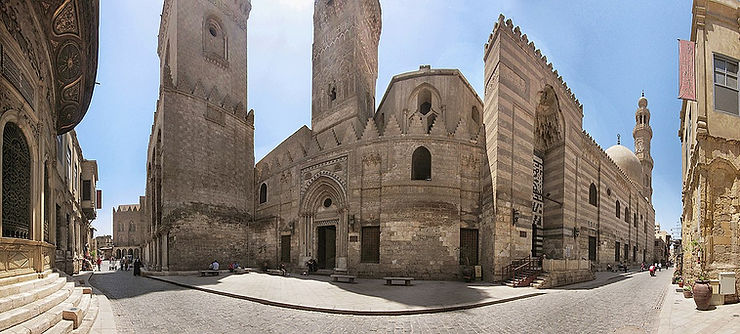
What You’ll See
There’s *a lot* to see while walking down El Moez Street, but we narrowed down the main sites and listed them in the order of what you’ll see walking from Bab el Fotouh at the north entrance down south to the Tentmakers’ Market where Moez officially ends. Ready? Take a stroll with us:
Bab El Fotouh
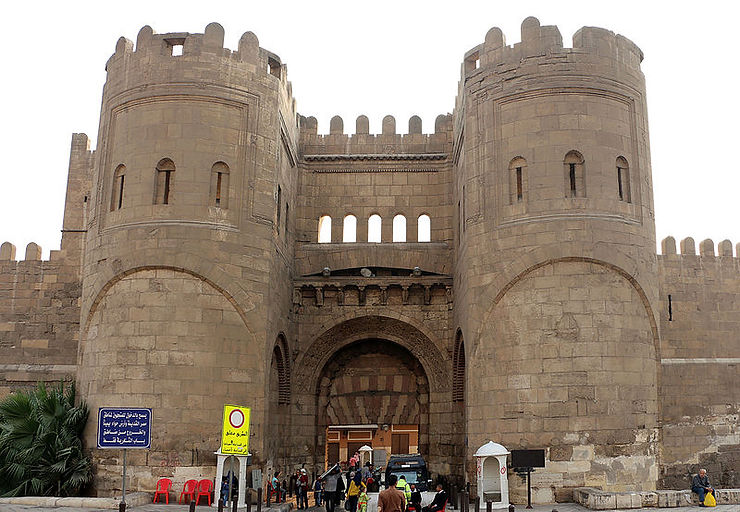
Built: 1087 AD
Islamic era: Fatimid
One of the last three remaining gates to the original walled city of Cairo, built by a Fatimid caliph. It has arrow slits and shafts for pouring boiling water or oil on attackers.
Bab El Nasr
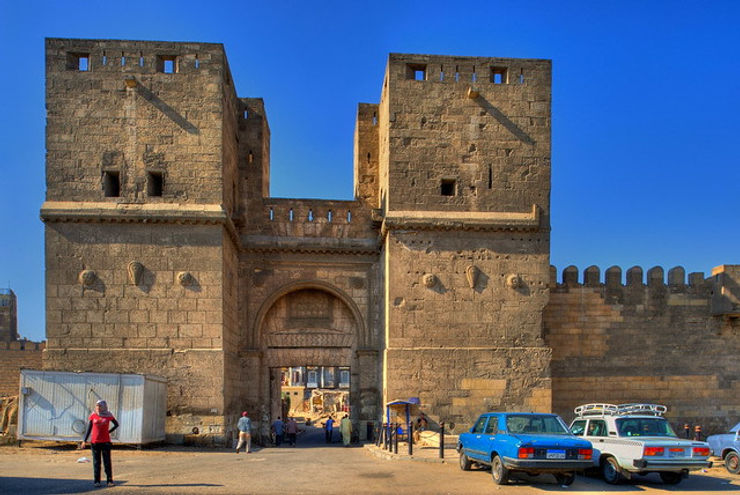
Built: 1087 AD
Islamic era: Fatimid
Before entering Moez Street from Bab El Fotouh, you can check out Bab El Nasr to the left of Bab el Fotouh. It’s one of the three remaining gates mentioned above, translating to Gate of Victory.
Al Hakim Mosque
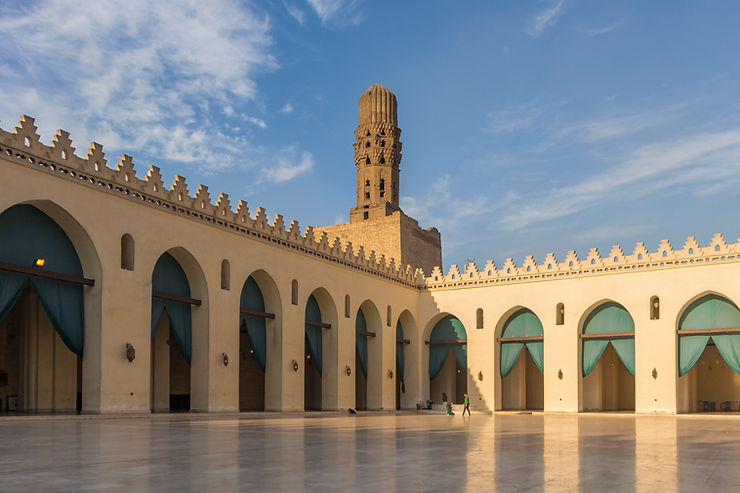
Built: 992 AD
Islamic era: Fatimid
Once you enter Moez Street, the first site you’ll find is the Al Hakim Mosque, short for Al-Hakim Bi-Amr Allah. Its minarets are the oldest surviving minarets in Cairo. During certain periods after its construction during the Fatimid dynasty, it was used as a prison for Latin Crusaders, a fortress for Napoleon and a school before returning to its original function as a mosque.
Mosque-Sabil of Sulayman Agha Al-Silahdar
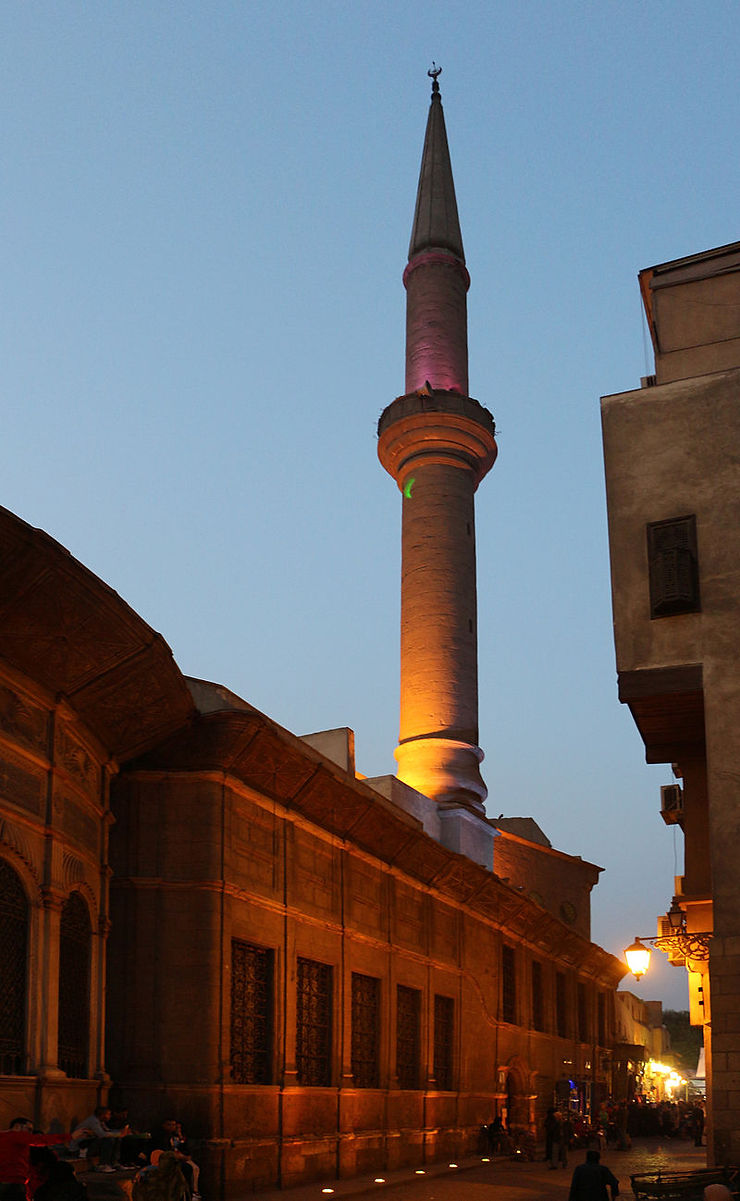
Built: 1839 AD
Islamic era: Ottoman
This religious complex of Sulayman Agha Al-Silahdar is a mosque, sabil (a building with the purpose of providing free drinking water to the public) and kuttab (a religious elementary school). Its design is known as ‘Ottoman baroque’.
Beit El Seheimy
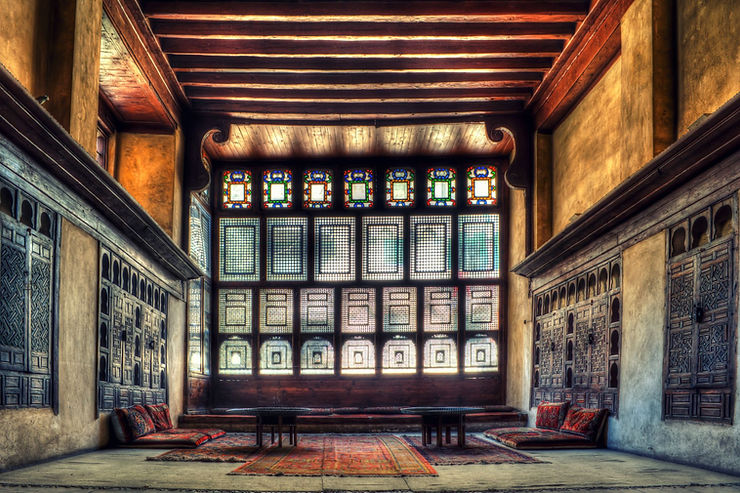
Built: 1648
Islamic era: Ottoman
Translating to ‘House of El Seheimy’, this historic house turned museum is a beautiful example of Ottoman residential architecture. It needs a ticket to enter (you can either buy a single ticket or a combo Moez Street one), but is definitely worth it. It’s found on Darb el Asfar, a lane intersecting with Moez Street which was an extremely expensive and affluent area of Islamic Cairo.
Al Aqmar Mosque
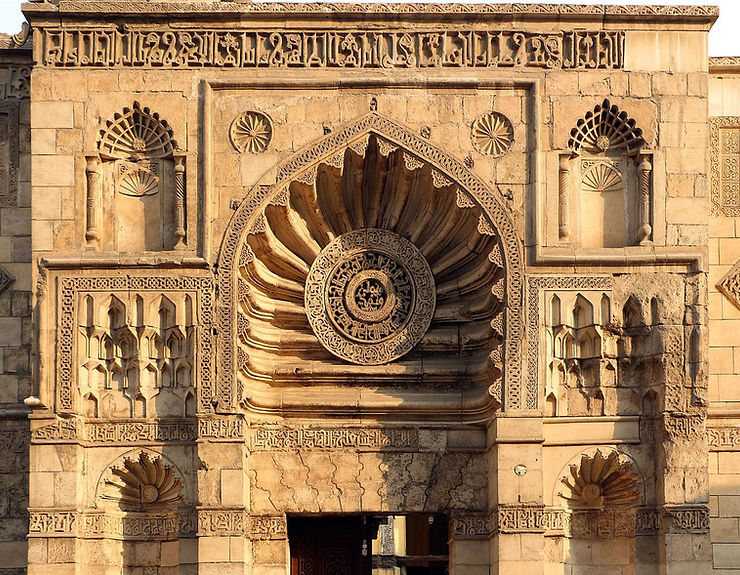
Built: 1126 AD
Islamic era: Fatimid
Translating to ‘Moonlit Mosque’, this mosque served the residents of early Cairo as well as the Great Fatimid Palace (no longer standing). It was the earliest mosque to have such an elaborate exterior facade and decoration.
Beshtak Palace
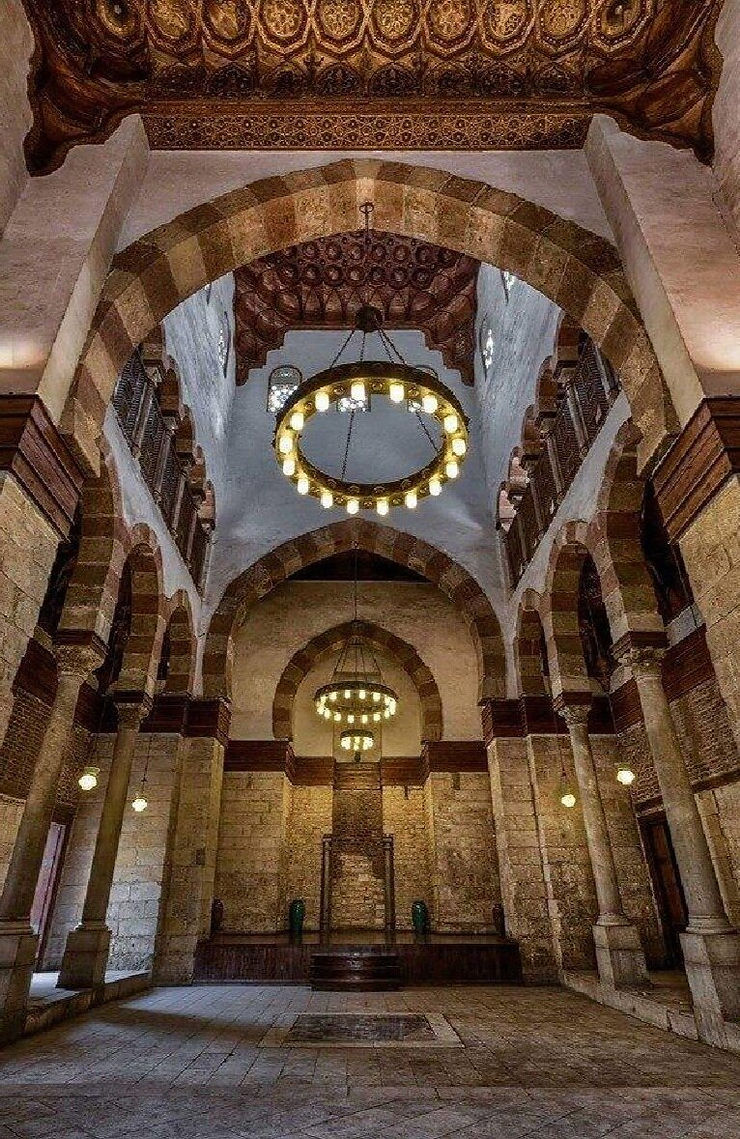
Built: 1339 AD
Islamic era: Mamluk
This palace turned museum was built in the 14th century by the Mamluk emir Beshtak (an emir was a powerful official or lord in the Mamluk dynasty). He built the palace to be his home and stables, and it’s a rare example of residential architecture at the time. Only part of the palace still exists, and is accessible via a ticket.
Sabil-Kuttab of Katkhuda
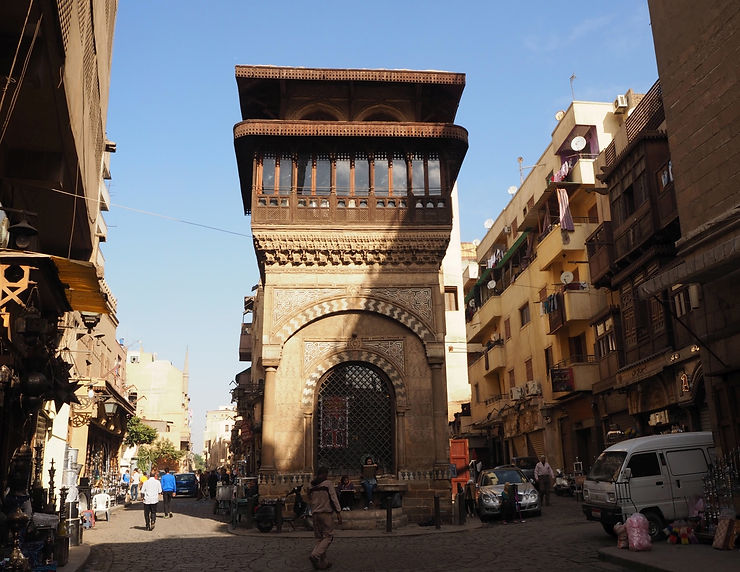
Built: 1744 AD
Islamic era: Ottoman
This public water fountain/building (sabil) and religious elementary school (kuttab) was built by Egyptian architect Katkhuda, and differs from the rest of Moez Street’s architecture in the sense that it’s free standing from 3 sides — it’s in the middle of the street. Although it was built during the Ottoman era, the design is Mamluk.
Hammam Inal

Built: 1456 AD
Islamic era: Mamluk
This medieval hammam (public bathhouse) was built by the Mamluk Sultan Inal. It’s one of the last remaining preserved historic hammams in Cairo; by the end of the 19th century there were around 80 hammams but now have dwindled down to just a few.
Al-Kamil School
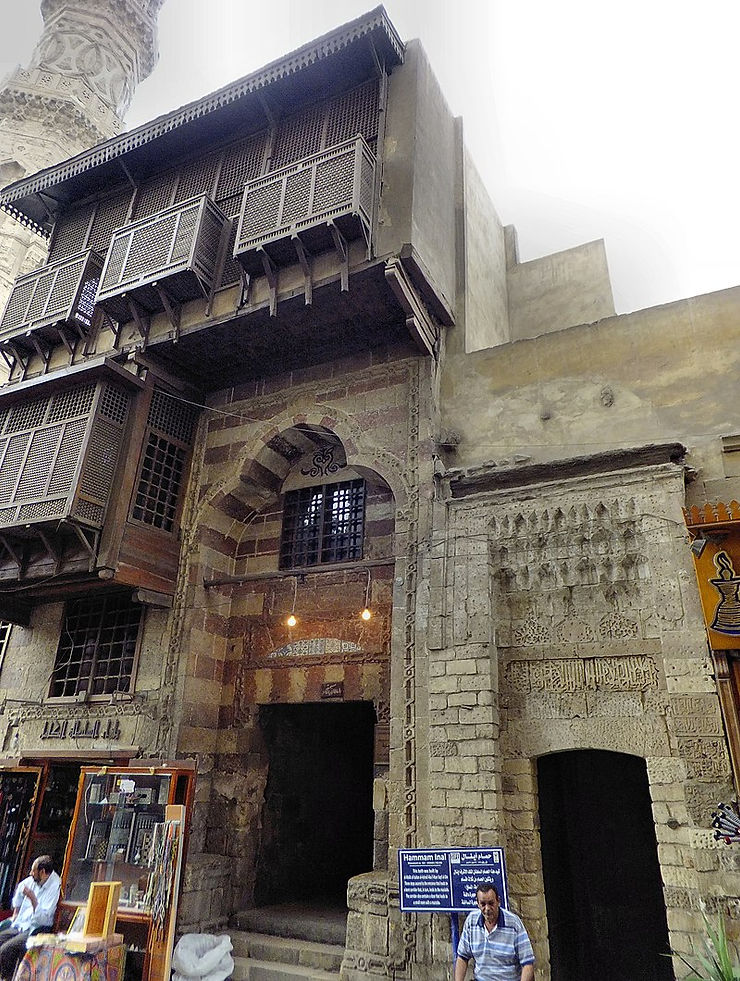
Built: 1229 AD
Islamic era: Ayyubid
Adjacent to the Hammam Inal is Al-Kamil School (also known as the Mosque-Madrasa of Al-Kamil Mohamed Ayyub or Kamileya School). It was one of the greatest theology schools in Egypt in the 13th century, but the building was largely destroyed in later centuries. It was restored during the Ottoman era, which shows through the Ottoman architecture (for example, the mashrabeya windows) that you can still see today.
Mosque-Madrasa of Sultan Barquq
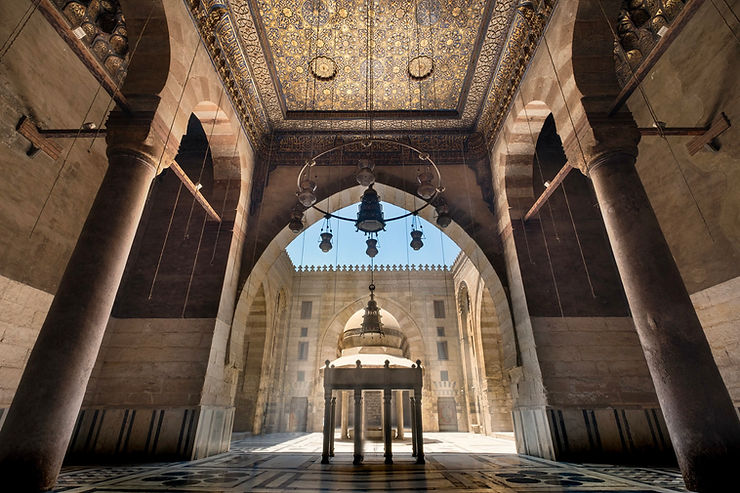
Built: 1386 AD
Islamic era: Mamluk
This religious complex was built by the Mamluk Sultan Al Zaher Barquq and houses not only a mosque but a ‘madrasa’ — a religious school dedicated to the four Islamic schools of thought. It’s adjacent to the madrasa of Al Nassir Mohamed, an earlier sultan. These two structures are thought to be some of the greatest Mamluk architecture in Cairo, alongside the Qalawun Complex (below).
Qalawun Complex
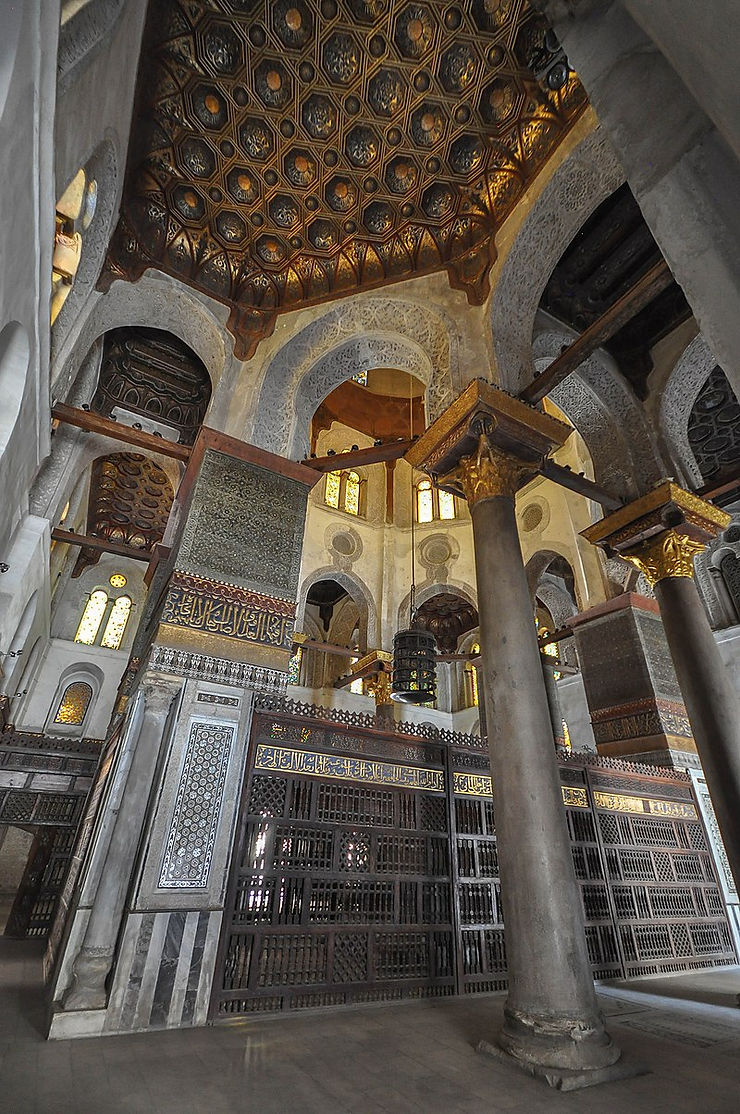
Built: 1285 AD
Islamic era: Mamluk
The funerary complex of Sultan Al-Mansour Qalawun was built over the ruins of one of the two original but no longer standing Fatimid palaces of Moez Street (giving this section of the street the name of ‘Bein el Qasrein’ — ‘between the two palaces’). The mausoleum at Qalawun Complex is considered to be the second most beautiful mausoleum in the world, second only to the Taj Mahal. Entrance is via ticket.
Sultan Al-Ashraf Barsbay Mosque
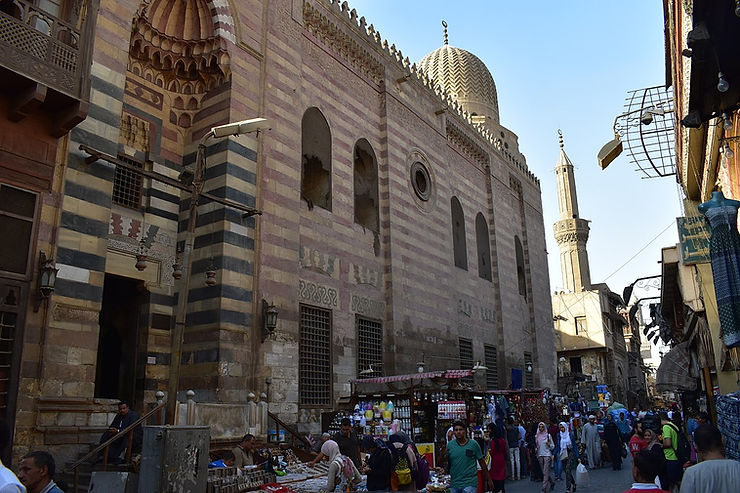
Built in: 1424 AD
Islamic era: Mamluk
Also known as Al Ashraf Mosque, the Barsbay mosque was part of Mamluk Sultan Al Ashraf Al Barsbay’s complex, alongside a mausoleum and Sufi lodgings (now destroyed). This mosque is known not only for its size but its marble mosaics and stained glass windows.
El Ghouri Complex

Built: 1505 AD
Islamic era: Mamluk
Cross Al Azhar street and you’ll continue Moez Street through the El Ghouri Complex, known as El Ghoureya in Arabic. El Ghoureya is a funerary complex for the second-to-last Mamluk sultan, El Ghouri. What makes this complex so different from anything else on the street is that it’s situated on both sides of Moez Street, with a wooden roof above connecting the two sides. It’s home to a mosque, mausoleum and religious school, but the main thing you’ll see are all the modern stalls and vendors peddling all kinds of clothes and textiles.
Al Muayyad Mosque
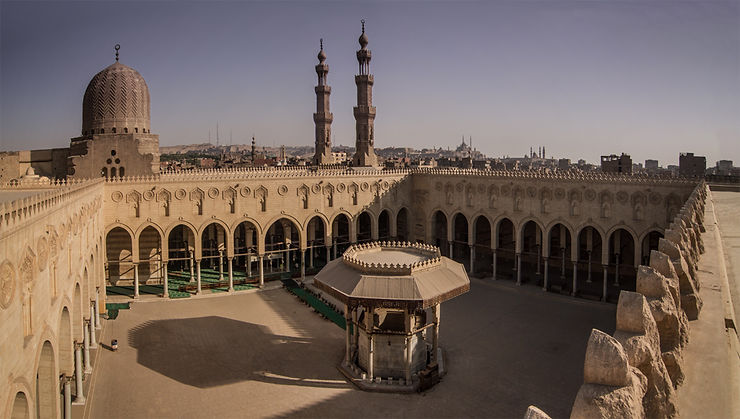
Photo credit: Guilhem de Cooman
Built in: 1421 AD
Islamic era: Mamluk
Close to Bab Zuweila (below), the Al Muayyad Mosque is considered the last great hypostyle mosque in Cairo. The interiors of the mosque were some of the most richly decorated at the time, although it’s said that some pieces were illegally taken from other mosques; Al Muayyad Mosque’s door and chandelier is said to come from the famous Sultan Hassan mosque.
Bab Zuweila
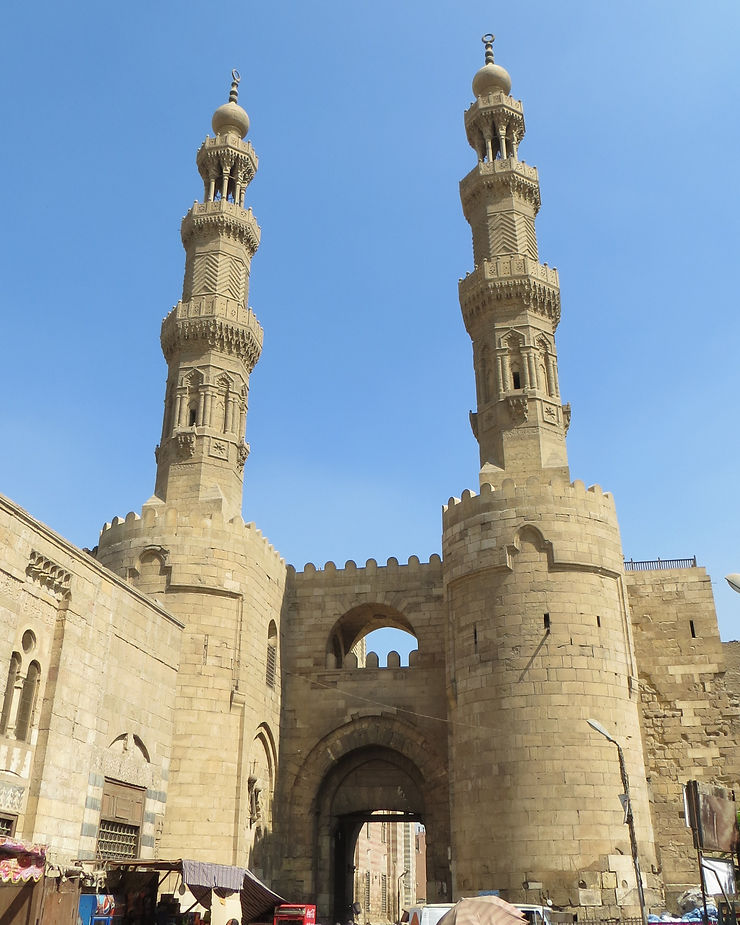
Built in: 1087 AD
Islamic era: Fatimid
The last remaining southern gate of the old Fatimid walled city of Cairo. Executions would sometimes take place here, with the heads of executed criminals displayed on the wall (which reminds us, RIP Ned Stark). Bab Zuweila is where Moez Street officially ends, but most explorers continue directly south to the tentmakers’ market.
Tentmakers’ Market (El Khayemeya)
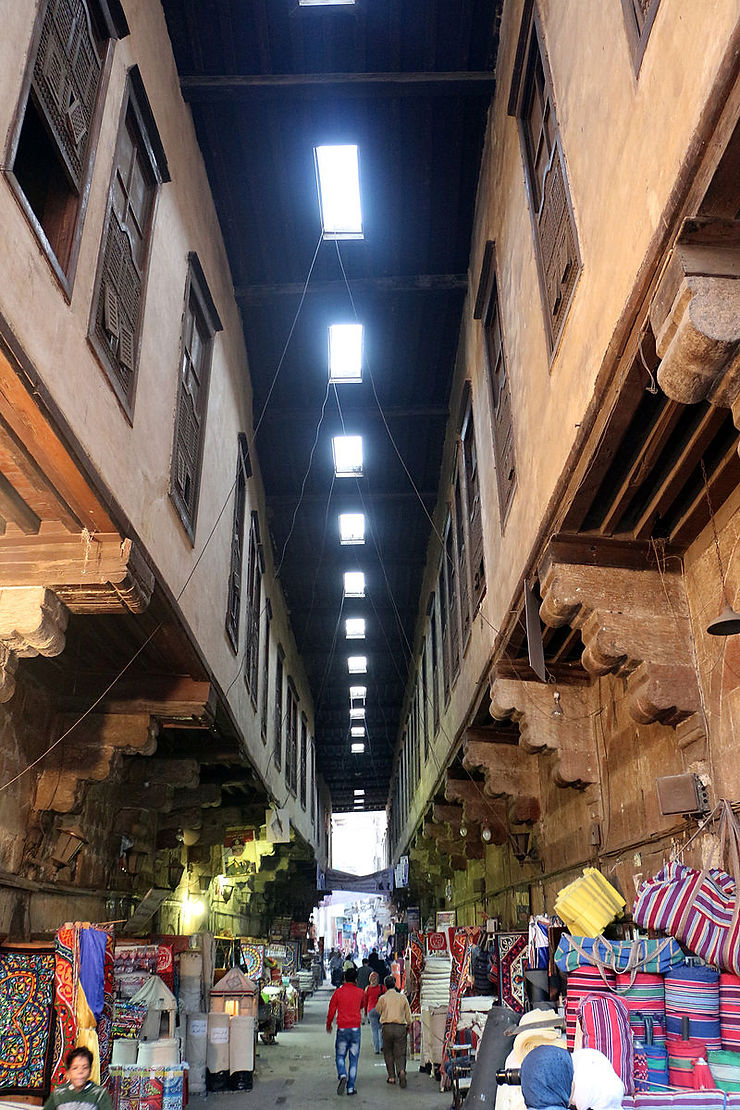
A covered market (one of Cairo’s very last) selling all different kinds of beautiful textiles: carpets, pillow cases, tapestries and colorful tent material that’s used all over Egypt in mosques, weddings, homes and holidays. The market itself is a small alley with a high roof with skylights for sunlight and ventilation. The goods sold at the different stalls are great examples of Egyptian handicrafts, and are super reasonably priced.
Extra: the Maimonides Synagogue
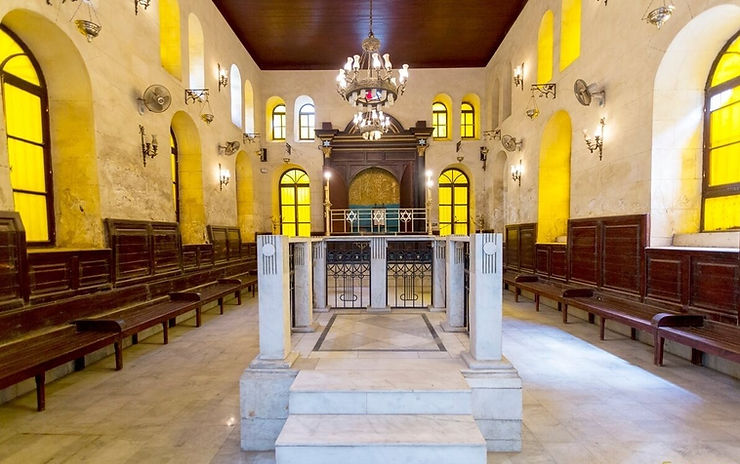
Built: 10th century originally
The Maimonides Synagogue (also known as Musa ben Maimoun Temple or Rav Moshe Synagogue) is kind of a bonus site for El Moez Street, mainly because it’s not actually on the street itself — it’s on a small side street about a 10 minute walk away, in what used to be known as the Jewish Quarter (Haret el Yehood). However, entry to the synagogue is included when you buy your combination Moez Street ticket. The synagogue had fallen into decay but was restored by the government in 2010.
Where to stay on Moez Street
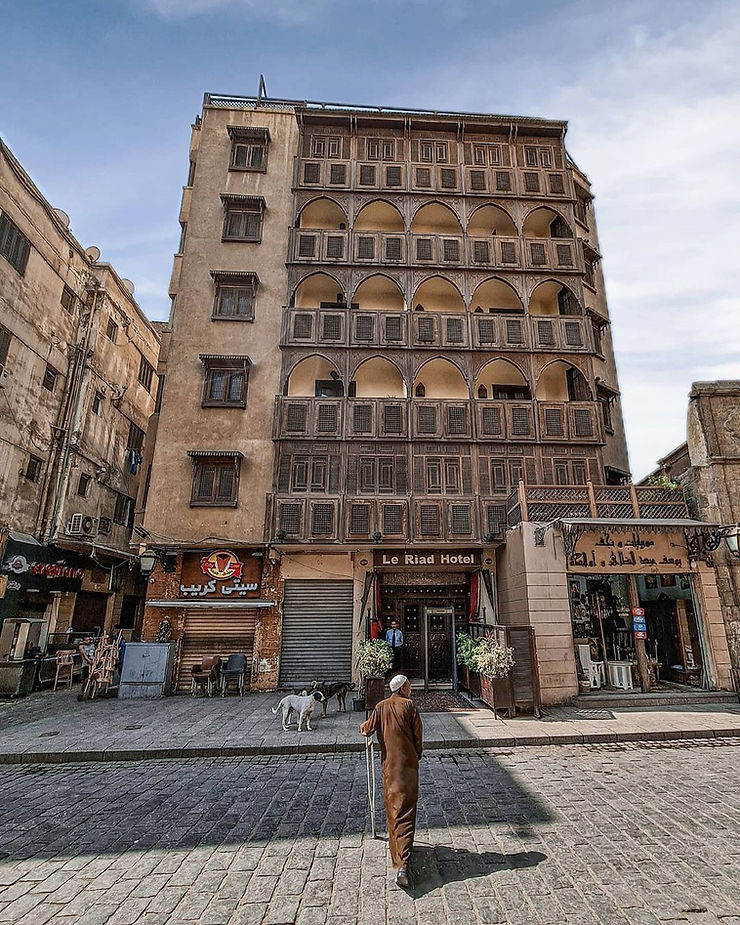
If you’re interested in staying in a hotel right in the heart of Moez Street, then look no further than Le Riad de Charme, a boutique hotel that embraces the history and architectural beauty of the area.
Read more: 8 Boutique Hotels in Egypt for a More Unique, Personalized Experience
The pros of staying in a hotel right on Moez Street are that you’ll be able to explore the street and Khan el Khalili for as long as you want without worrying about fitting it all in one day or having to make several trips. It’s a good base in general if your main interest is Islamic Cairo as a whole: which includes not only Moez Street and Khan el Khalili but the Citadel, Sultan Hassan & El Rifai mosques, Ibn Tulun and City of the Dead as well.
The cons of staying in a hotel on Moez Street are that it gets pretty crowded and busy, and traffic is a hassle if you want to explore Cairo outside of that area. Also Old Cairo/Islamic Cairo in general doesn’t have a plethora of good restaurants, plus they don’t serve alcohol, so you’ll be a distance away from any nightlife.
Where to eat on Moez Street
While that area is known for having either tourist trap restaurants or just mediocre food in general, here are a few we recommend:
- Naguib Mahfouz Cafe & Khan El Khalili Restaurant

This is actually one restaurant, but we locals mainly refer to it just as Naguib Mahfouz Cafe. It’s not technically on Moez Street, but very close by in the Khan el Khalili market. It’s run by the Oberoi group, which ensures that the quality of food never dips, and in fact it’s one of our favorite restaurants in Cairo to bring foreign friends. The menu has all the Egyptian classics, the inner decor is ambient and fits its surroundings and they have live music most nights – but make sure you reserve before you go though, they’re always fully booked!
2. Zeeyara
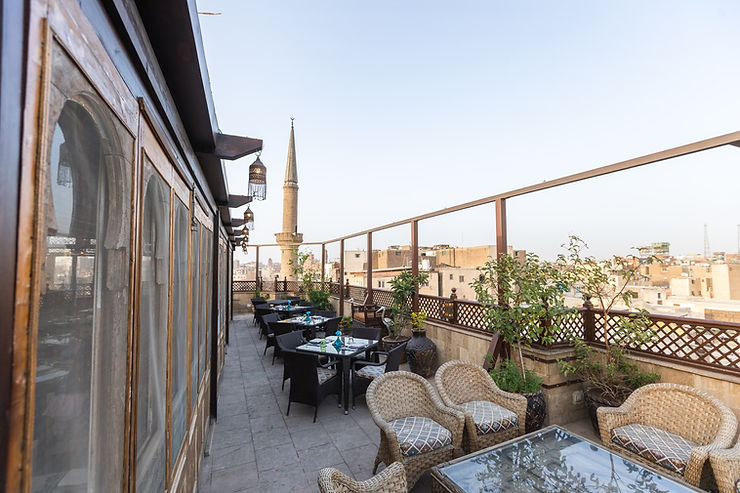
The boutique hotel on Moez Street that we mentioned above, Le Riad de Charme, has a very cute rooftop restaurant called Zeeyara that overlooks several of the medieval monuments.
3. Tekiyt Khan Khatoun (Beit Zeinab Khatoun)
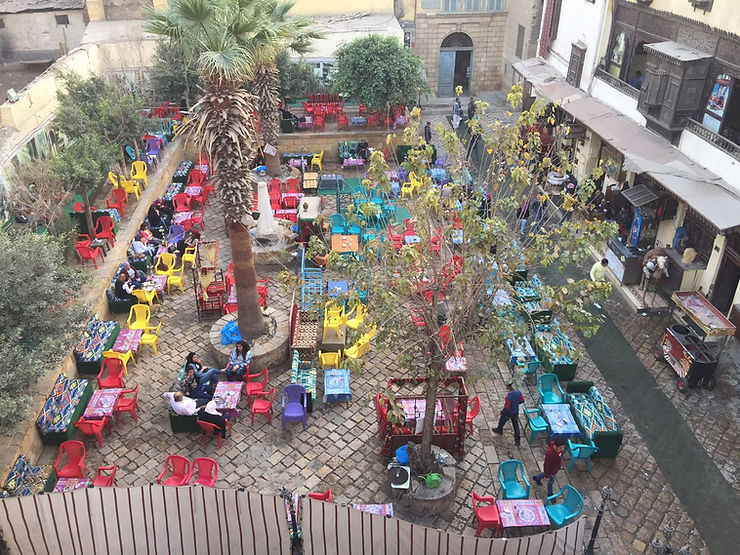
This restaurant/cafe isn’t on Moez Street itself, but is nearby behind the Al Azhar Mosque (on El Azhar street, which intersects with Moez Street). You’ll find the restaurant in the courtyard of Beit Zeinab Khatoun, a historical Mamluk house built in 1486.
Read more: Oldest Restaurants, Bars and Cafes in Cairo
This spot is recommended more for a snack, coffee or shisha during your Moez Street visit, although they do have a full menu of Egyptian and international dishes (we recommend ordering the Egyptian options).
And that’s a wrap for Moez Street! But before you leave the area, make sure you check out the world-famous souq and bazaar Khan el Khalili which is adjacent to Moez Street (you’ll have to double back a little back from Bab Zuweila).
How to leave:
You can catch a cab from the narrow street right outside Bab Zuweila, but it’s probably easier to head back to Al Azhar street (where El Ghoureya is), and get a cab from there or have an Uber pick you up. Or if you’re exploring Khan el Khalili before you leave, hop in a cab from El Hussein Square.
You might also like: Coptic Cairo – A Detailed Local’s Guide

